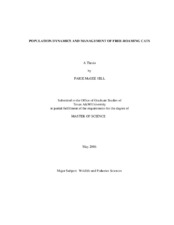Population dynamics and management of free-roaming cats
Abstract
With an estimated 400 million domestic cats worldwide, free-roaming cats issues are of global importance due to animal welfare and public health concerns, as well as impacts on native wildlife through predation, competition and disease transmission. Though these impacts have been well documented, no research has evaluated the ecology and population dynamics of unmanaged, free-roaming cat populations using radio-telemetry. My objectives were to (1) compare population demographics (survival, fecundity and annual ranges/movements) among sex and ownership classifications (feral, semi-feral, and owned), (2) evaluate mark-resight and distance sampling for estimating cat abundances in urban areas, and (3) evaluate the effectiveness and costs associated with euthanasia and trap/treat/neuter/release (TTNR) programs for controlling urban cat populations. I radio-collared free-roaming cats (feral, n = 30; semi-feral, n = 14; owned, n = 10) in Caldwell, Texas (October 2004-2005). I found (1) increased levels of ownership or feeding reduce free-roaming catsÂ’ ranges and movements while increasing survival and fecundity, (2) distance sampling resulted in precise abundance estimates providing an alternative to estimating urban cat densities, and (3) both euthanasia and TTNR may effectively reduce free-roaming cat numbers if implemented at high rates (>50% of population treated) the first year. I recommend euthanasia be implemented in ecologically sensitive areas and TTNR in areas lacking public support for lethal control. Population control solutions should include public education to increase awareness of cat issues and impacts, and pre- and post-implementation monitoring plans.
Citation
Hill, Paige McGee (2006). Population dynamics and management of free-roaming cats. Master's thesis, Texas A&M University. Texas A&M University. Available electronically from https : / /hdl .handle .net /1969 .1 /3842.


